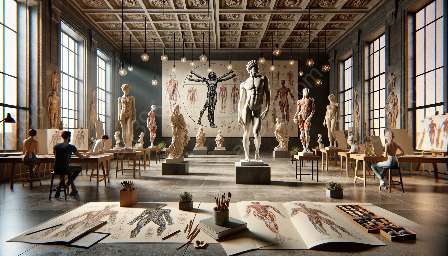Artistic anatomy is fundamental for artists, serving as the cornerstone for the representation of the human form in visual art. However, it is the integration of dynamic anatomy that truly brings life and energy to artistic compositions. Dynamic anatomy refers to the study of anatomic structures in motion, capturing the fluidity and movement of the human body. Understanding dynamic anatomy is crucial for artists aiming to depict dynamic and engaging compositions.
Understanding Dynamic Anatomy
Dynamic anatomy delves into the interconnectedness of muscles, tendons, and bones during movement. It explores how these elements contribute to the overall balance and harmony of the human form in motion. By comprehending dynamic anatomy, artists gain insight into how to accurately depict the tension, flow, and rhythm of the body in various poses and actions. This understanding allows them to infuse their artwork with a sense of dynamism and vitality.
Impact on Composition
Dynamic anatomy profoundly influences the composition of visual art. Through a grasp of dynamic anatomy, artists can effectively convey movement, energy, and balance within their compositions. Whether it’s a figure in motion or a dynamic scene, the knowledge of dynamic anatomy enables artists to ensure that their subjects are not only anatomically correct but also visually compelling.
Balance and Proportion
Dynamic anatomy plays a pivotal role in achieving balance and proportion in visual art. The understanding of how the human body moves and balances itself allows artists to create artworks that exude a natural sense of equilibrium and grace. Whether it's a dynamic action pose or a serene, balanced composition, dynamic anatomy provides the foundation for artists to achieve visual harmony within their works.
Expressive Potential
By integrating dynamic anatomy into their artistic practice, creators can unleash the expressive potential of their work. The depiction of dynamic anatomy empowers artists to convey emotion, strength, and narrative through the body language and gestures of their subjects. This adds depth and resonance to their artistic creations, connecting with viewers on a visceral and emotional level.
Merging Artistic Anatomy with Dynamic Anatomy
While artistic anatomy forms the basis for understanding the human figure, dynamic anatomy enhances this knowledge by providing insight into the body's movement and energy. By integrating the principles of dynamic anatomy into their understanding of artistic anatomy, artists can create visually striking and emotionally charged compositions that resonate with viewers.
Conclusion
Dynamic anatomy is indispensable in shaping the composition and balance of visual art. It equips artists with the knowledge and skills to infuse their works with movement, energy, and emotional depth. By understanding and integrating dynamic anatomy into their artistic practice, creators can breathe life and dynamism into their compositions, captivating audiences and evoking powerful emotions through their art.

